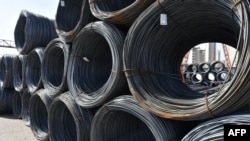President Donald Trump on Monday fired another volley in his ongoing trade war, announcing 25% tariffs on steel and aluminum imports and canceling exemptions and duty-free quotas for major suppliers.
“It’s a big deal,” Trump said, the thick black marker in his right hand hovering over the executive order.
“This is the beginning of making America rich again,” he said, dragging his distinctive jagged signature over the paper.
Billionaire financier Howard Lutnick, Trump’s nominee to lead the Commerce Department, watched from over Trump’s left shoulder in the Oval Office. Trump's trade adviser said this move will help domestic producers and support U.S. economic and national security. Lutnick spoke of the 120,000 jobs this could bring back.
“You are the president who is standing up for the American steelworker, and I am just tremendously impressed and delighted to stand next to you,” Lutnick said.
The nuts and bolts
Trump’s proclamations raised the rate on aluminum imports to 25% from the previous 10% that he imposed in 2018 to aid the struggling sector. And he restored a 25% tariff on millions of tons of steel and aluminum imports.
Trump’s actions also will impose a new North American standard requiring steel imports to be "melted and poured" and aluminum to be "smelted and cast" in the region to curb imports of minimally processed Chinese steel.
The order also targets downstream steel products that use imported steel for tariffs.
Trump's trade adviser, Peter Navarro, said the measures would help U.S. steel and aluminum producers and shore up America's economic and national security.
"The steel and aluminum tariffs 2.0 will put an end to foreign dumping, boost domestic production and secure our steel and aluminum industries as the backbone and pillar industries of America's economic and national security," he told reporters.
"This isn't just about trade. It's about ensuring that America never has to rely on foreign nations for critical industries like steel and aluminum," Navarro said.
What now?
Trump first broached the steel and aluminum action Sunday — and the move drew instant pushback in what is unfolding as a tit-for-tat exchange.
Earlier Monday, Beijing enacted additional tariffs on U.S. goods as a countermeasure to Trump’s earlier 10% hike on Chinese goods.
“There are no winners in trade wars and tariff wars,” said Guo Jiakun, a spokesperson for China’s Ministry of Foreign Affairs. “They harm the interests of the people of both countries. What is needed now is not unilateral tariff increases but equal dialogue and consultation based on mutual respect. We urge the U.S. to correct its wrong practices and stop politicizing and instrumentalizing economic and trade issues.”
Most economists believe tariffs raise consumer prices. Scholars of supply chains and logistics say Trump’s move also raises major global policy questions.
“It's not clear whether this is a negotiating strategy, whether this is going to be permanent,” said Professor Sunderesh Heragu of Oklahoma State University. “Is this only restricted to Canada, Mexico and China as it is now, or is it going to expand to the European Union, for example, or even the BRICS countries, of which, you know, Brazil, Russia, India, China, South Africa and 12 or 14 other countries, are part of?”
He said these concerns may prompt countries to realign their trade relationships, which will likely alarm producers.
“It clearly causes a lot of confusion, and you know, businesses, again, hate uncertainty,” Heragu said. “So, they're going to put everything on pause. That means, you know, there could be a decrease in production activity, while at the same time, the tariffs could have inflationary effects.”
Some in the automotive industry in Detroit, the U.S.’ “Motor City,” echoed that concern.
"Sudden tariffs to a system — there isn't a lot of good that comes out of that,” said Glenn Stevens Jr., executive director of MichAuto and vice president of automotive and mobility initiatives at the Detroit Regional Chamber.
Studies attempting to understand the impact of these moves yield mixed pictures. The Washington, D.C.-based Tax Foundation estimates that the tariffs will generate around $100 billion each year in federal tax revenue.
Another analysis shows they could “impose significant costs on the broader economy: disrupting supply chains, raising costs for businesses, eliminating hundreds of thousands of jobs and ultimately driving up consumer prices.”
Some information for this article came from Reuters.










